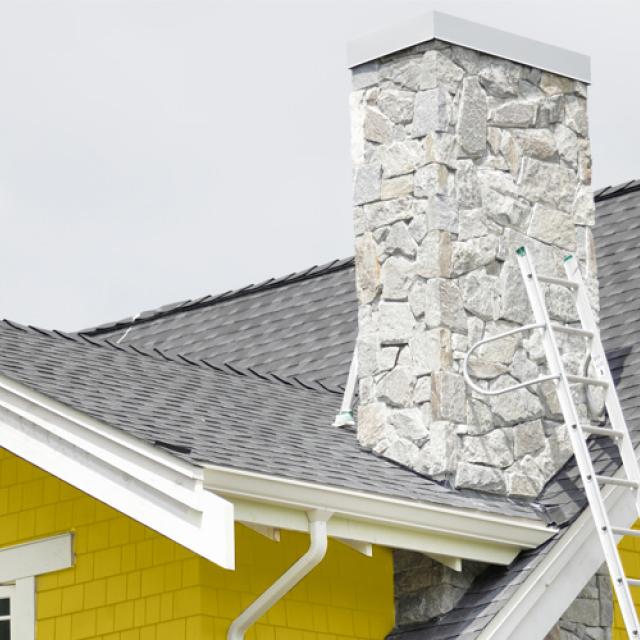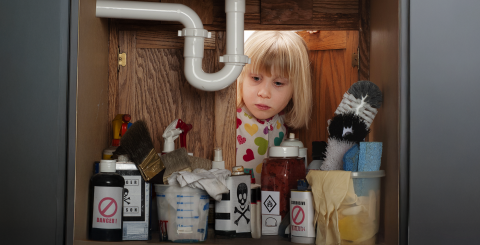When to clean your chimney, and how to do it

When it’s cold outside, a warm fire feels cozy and relaxing. Whether wood is your primary or secondary heat source, keeping the chimney clean is key to enjoying the benefits of your fireplace or wood stove while minimizing the risks. Of course, you’re covered by your home insurance, but prevention is the best insurance of all for safely heating your home.
Why, when, and how should you clean your chimney? Read on for the answers.
Why clean your chimney?
There are two main reasons for having your chimney cleaned: to prevent damage from an accidental fire and smoke and to avoid the risk of carbon monoxide poisoning. These are serious concerns that can be a real danger.
Check for creosote
Every time you burn wood, soot and tar leave residue that causes creosote to build up inside your chimney. What is creosote? It’s what is left behind when droplets of tar condense on the walls of your chimney. The principle is simple: The more logs you burn, the more creosote—a highly flammable substance—builds up over time.
According to the National Fire Code of Canada, a layer of creosote or soot thicker than 3 millimetres (1/8 inch) is a fire risk. A clean chimney is a chimney that does what it was designed to do: direct gas and smoke out of your house.
Beware of carbon monoxide
Having your chimney cleaned not only prevents chimney fires but also greatly lowers the risk of carbon monoxide poisoning. A poorly functioning fireplace can produce this odourless, colourless, and highly toxic gas. That’s why if you have a wood-burning fireplace put in, you are required to have a carbon monoxide detector.
Safety tips – To reduce the amount of creosote, use only dry wood. Don’t burn plastic, painted wood, treated wood, or wood containing glue, such as plywood. Toxic chemicals from any of these materials can cause creosote buildup.
How to clean your chimney
We’ve covered the why. Now let’s find out how. Knowing how to clean your chimney is crucial. Patience and attention to detail are crucial. Hasty and sloppy work will not make your chimney safe.
Cleaning your chimney yourself
Make sure your brush is the right shape and size and thoroughly scrub the entire flue. Be sure to:
- Brush all the components (chimney, vent connectors, and the flue). Clean inside and out and gather up the soot
- If your system has deflectors, remove them to clean off soot and ash buildup
- Read the user manual for your wood-burning appliance and follow all safety and maintenance instructions
- Seek professional advice if you need it
Choose the right brush for your chimney. If you have a stainless steel prefabricated chimney or chimney liner, a polypropylene brush is best because it won’t leave any corrosive metal deposits. Or you could use a fine-gauge wire brush specially designed for these chimneys. There are also a variety of steel brushes for masonry chimneys.
Hot ashes – To safely dispose of hot ashes, use a metal scoop (not a vacuum cleaner!) and put them in a metal container (not a plastic one!) with a raised bottom and a metal lid. Clean out the ashes regularly. Hot ashes release carbon monoxide, so take the container outside, place it on a non-combustible surface, and keep at least one meter of clear space around it. Ashes can stay hot for up to seven days, so wait at least a week before emptying the container and make sure the ashes are completely cold.
If you hire a professional
The best way to clean your chimney is to hire a pro. A certified chimney sweep is qualified to do whatever needs to be done inside and outside your home and to do a complete inspection of all your chimney’s components. They can point out anything you need to have repaired.
When to clean your chimney
When should you clean your chimney? At least once a year. Spring is ideal. The heating season has just ended, so creosote buildup is easier to remove. And you’ll have plenty of time to get any repairs taken care of before the cold weather hits again.
Depending on how often you use your fireplace and the type of wood you burn, your chimney may need to be cleaned more frequently. These are the things you should be doing and the signs to watch out for:
- Monitor creosote buildup inside the chimney.
- Once the layer of buildup is 4 millimetres thick, clean the chimney and the vent connector.
- Watch for: wear and tear (cracking, warping, etc.); corrosion (vent connectors, lining, exterior surface); rust spots (exterior surface); swelling (lining); black or white spots (exterior bricks); and cracks or missing pieces (lining).
- Check your home insurance, including coverage for fires. If you change how often you use a wood-burning appliance or buy a new one, let your insurer know right away.
By following these tips for cleaning your chimney safely and correctly, you can enjoy all the pleasures of trouble-free wood heating. If you’re thinking of installing a fireplace or a wood stove, first check whether there are any local regulations you need to follow.
Feel free to contact Promutuel Insurance for a home insurance quote. Stay warm and cozy at home—with complete peace of mind!




